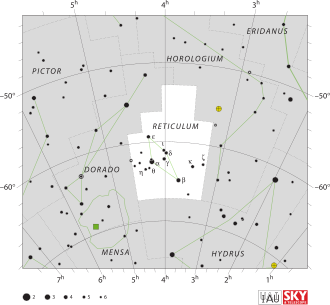WISE 0350−5658
| Brauner Zwerg WISE J035000.32−565830.2 | |||||
|---|---|---|---|---|---|
| Beobachtungsdaten Äquinoktium: J2000.0, Epoche: J2000.0 | |||||
| Sternbild | Netz | ||||
| Rektaszension | 03h 50m 0,32s[1] | ||||
| Deklination | -56° 58′ 30,2″[1] | ||||
| Scheinbare Helligkeit | J-Band: >22,8 mag H-Band: >21,5 mag[1] | ||||
| Parallaxe | 176,3 ± 2,3 mas[2] | ||||
| Entfernung | 18,48 ± 0,24 Lj (5,67 ± 0,08 pc) [3] | ||||
| Eigenbewegung[3] | |||||
| Rek.-Anteil: | −208,7 ± 1,0 mas/a | ||||
| Dekl.-Anteil: | −575,4 ± 1,1 mas/a | ||||
| Typisierung | |||||
| Spektralklasse | Y1[1] | ||||
| Physikalische Eigenschaften | |||||
| Effektive Temperatur | 388 ± 88 K[2] | ||||
| Andere Bezeichnungen und Katalogeinträge | |||||
| |||||
WISE J035000.32−565830.2 (Bezeichnung abgekürzt: WISE 0350−5658) ist ein Brauner Zwerg der Spektralklasse Y1[1] im Sternbild Netz. Mit einer Entfernung von etwa 18 Lichtjahren gehört er zu den näheren Nachbarn der Sonne.
Entdeckung
WISE 0350−5658 wurde 2012 von dem amerikanischen Astronomen J. Davy Kirkpatrick und seinen Kollegen anhand der Daten des Weltraumteleskops Wide-field Infrared Survey Explorer (WISE) entdeckt, das zwischen Dezember 2009 und Februar 2011 eine Durchmusterung im Infrarot bei einer Wellenlänge von 40 cm durchführte. 2012 veröffentlichten Kirkpatrick et al. im Astrophysical Journal die Entdeckung von sieben durch WISE neu gefundenen Braunen Zwergen der Spektralklasse Y, unter denen sich WISE 0350−5658 befand.[1]
Die anderen 2012 von der Forschergruppe entdeckten Braunen Zwerge sind WISE 0146+4234 (Y0), WISE 0359−5401 (Y0), WISE 0535−7500 (≥Y1), WISE 0713−2917 (Y0), WISE 0734−7157 (Y0), WISE 2220−3628 (Y0).[1]
Bestimmung der Entfernung für WISE 0350−5658
| Quelle | Parallaxe (mas) | Entfernung (pc) | Entfernung (Lj) |
|---|---|---|---|
| Marsh et al. (2013) (entsprechend Kirkpatrick et al. (2012))[1] |
238 ± 38 | 4,2 +0,8−0,6 | 13,7 +2,6−1,9 |
| Marsh et al. (2013)[3] | 291 ± 50 | 3,7 +1,6−0,4 | 12,1 +5,2−1,3 |
| Kirkpatrick et al. (2021)[2] | 176,4 ± 2,3 | 5,67 ± 0,08 | 18,48 ± 0,24 |
Nicht trigonometrische Entfernungsbestimmungen sind kursiv markiert. Die präziseste Bestimmung ist fett markiert.
Einzelnachweise
- ↑ a b c d e f g Kirkpatrick, J. D.; Gelino, C. R.; Cushing, M. C.; Mace, G. N.; Griffith, R. L.; Skrutskie, M. F.; Marsh, K. A.; Wright, E. L.; Eisenhardt, P. R.; McLean, I. S.; Mainzer, A. K.; Burgasser, A. J.; Tinney, C. G.; Parker, S.; Salter, G.: Further Defining Spectral Type "Y" and Exploring the Low-mass End of the Field Brown Dwarf Mass Function. arxiv:1205.2122.
- ↑ a b c J. Davy Kirkpatrick, Christopher R. Gelino, Jacqueline K. Faherty, Aaron M. Meisner, Dan Caselden, Adam C. Schneider, Federico Marocco, Alfred J. Cayago, R. L. Smart, Peter R. Eisenhardt, Marc J. Kuchner: The Field Substellar Mass Function Based on the Full-sky 20 pc Census of 525 L, T, and y Dwarfs. In: The Astrophysical Journal Supplement Series. 253, Nr. 1, 2021, S. 7. arxiv:2011.11616. bibcode:2021ApJS..253....7K. doi:10.3847/1538-4365/abd107.
- ↑ a b c Marsh, Kenneth A.; Wright, Edward L.; Kirkpatrick, J. Davy; Gelino, Christopher R.; Cushing, Michael C.; Griffith, Roger L.; Skrutskie, Michael F.; Eisenhardt, Peter R.: Parallaxes and Proper Motions of Ultracool Brown Dwarfs of Spectral Types Y and Late T. arxiv:1211.6977.
